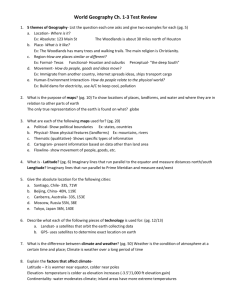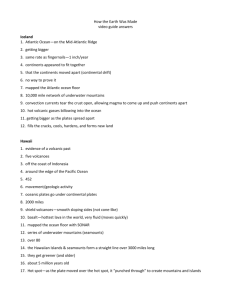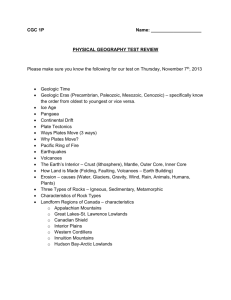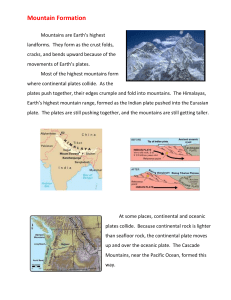The Effects of Moving Plates
advertisement
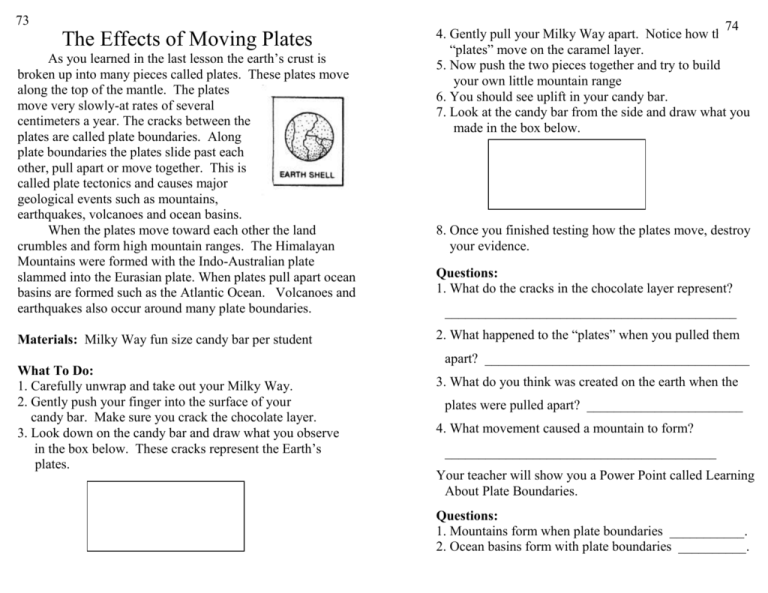
73 The Effects of Moving Plates As you learned in the last lesson the earth’s crust is broken up into many pieces called plates. These plates move along the top of the mantle. The plates move very slowly-at rates of several centimeters a year. The cracks between the plates are called plate boundaries. Along plate boundaries the plates slide past each other, pull apart or move together. This is called plate tectonics and causes major geological events such as mountains, earthquakes, volcanoes and ocean basins. When the plates move toward each other the land crumbles and form high mountain ranges. The Himalayan Mountains were formed with the Indo-Australian plate slammed into the Eurasian plate. When plates pull apart ocean basins are formed such as the Atlantic Ocean. Volcanoes and earthquakes also occur around many plate boundaries. Materials: Milky Way fun size candy bar per student 74 4. Gently pull your Milky Way apart. Notice how the “plates” move on the caramel layer. 5. Now push the two pieces together and try to build your own little mountain range 6. You should see uplift in your candy bar. 7. Look at the candy bar from the side and draw what you made in the box below. 8. Once you finished testing how the plates move, destroy your evidence. Questions: 1. What do the cracks in the chocolate layer represent? ___________________________________________ 2. What happened to the “plates” when you pulled them apart? _______________________________________ What To Do: 1. Carefully unwrap and take out your Milky Way. 2. Gently push your finger into the surface of your candy bar. Make sure you crack the chocolate layer. 3. Look down on the candy bar and draw what you observe in the box below. These cracks represent the Earth’s plates. 3. What do you think was created on the earth when the plates were pulled apart? _______________________ 4. What movement caused a mountain to form? ________________________________________ Your teacher will show you a Power Point called Learning About Plate Boundaries. Questions: 1. Mountains form when plate boundaries ___________. 2. Ocean basins form with plate boundaries __________. 75 Materials: Tectonic Plate Map from last lesson, Colored pencils What To Do: 1. Draw a dot on your map where 35°N and 70°E intersect with a green colored pencil. 2. Draw another dot where 30°N and 90°E intersect. 3. Connect the dots with a line and write “Himalayan Mountains” as close to the line as possible. 4. Draw two arrows pointing toward each other, with one arrow on either side of the Himalayan Mountains. 75 Materials: Tectonic Plate Map from last lesson, Colored pencils What To Do: 1. Draw a dot on your map where 35°N and 70°E intersect with a green colored pencil. 2. Draw another dot where 30°N and 90°E intersect. 3. Connect the dots with a line and write “Himalayan Mountains” as close to the line as possible. 4. Draw two arrows pointing toward each other, with one arrow on either side of the Himalayan Mountains. 5. Using a blue colored pencil draw a small square at the intersection of points 60°N and 30°W. 6. Draw another square at the intersection of 40°N and 30°W. 7. Draw another square at the intersection of 15°N and 45°W. 8. Draw another square at the intersection of 45°S and 20°W. 9. Draw a line to connect the squares in the order they were drawn. Label this line: Mid-Atlantic Ridge.” 5. Using a blue colored pencil draw a small square at the intersection of points 60°N and 30°W. 6. Draw another square at the intersection of 40°N and 30°W. 7. Draw another square at the intersection of 15°N and 45°W. 8. Draw another square at the intersection of 45°S and 20°W. 9. Draw a line to connect the squares in the order they were drawn. Label this line: Mid-Atlantic Ridge.” 10. Draw 10 small red triangles on the west coast of South America, starting at 0° latitude and ending at 50°S. 11. Draw a line connecting all the triangles and label it “Andes Mountains.” 10. Draw 10 small red triangles on the west coast of South America, starting at 0° latitude and ending at 50°S. 11. Draw a line connecting all the triangles and label it “Andes Mountains.” 12. With an orange colored pencil, write the letter F, for Fault, at the intersection of 30°N and 120°W. 13. Write another letter F at the intersection of 40°N and 123°W. 14. Connect the Fs with a line and label it “San Andreas Fault.” Questions: 1. What are the effects of 2 plates crashing into each other? 12. With an orange colored pencil, write the letter F, for Fault, at the intersection of 30°N and 120°W. 13. Write another letter F at the intersection of 40°N and 123°W. 14. Connect the Fs with a line and label it “San Andreas Fault.” Questions: 1. What are the effects of 2 plates crashing into each other? 2. What are the effects of 2 plates pulling apart? _____________________________________________ 2. What are the effects of 2 plates pulling apart? _________________________________________ Name ______________________ 76 period ____ EXIT TICKET 1. When plates push together they cause A. Ocean basins B. Mountains C. River Valleys D. Glaciers 2. When plates pull apart they cause A. Ocean basins B. Mountains C. River Valleys D. Glaciers 3. When plates slide past each other they cause A. Ocean basins B. Volcanoes and Earthquakes C. River Valleys D. Glaciers 4. When plates slide past each other they cause to crack to form in the earth. This crack is called a – A. Volcano B. Mountain C. River Valley D. Fault 5. The only place you can see the Mid-Atlantic Ridge on land is A. The Himalayan Mountains B. The Andes Mountains C. Iceland D. The San Andreas Fault Name ______________________ 76 period ____ EXIT TICKET 1. When plates push together they cause A. Ocean basins B. Mountains C. River Valleys D. Glaciers 2. When plates pull apart they cause A. Ocean basins B. Mountains C. River Valleys D. Glaciers 3. When plates slide past each other they cause A. Ocean basins B. Volcanoes and Earthquakes C. River Valleys D. Glaciers 4. When plates slide past each other they cause to crack to form in the earth. This crack is called a – A. Volcano B. Mountain C. River Valley D. Fault 5. The only place you can see the Mid-Atlantic Ridge on land is A. The Himalayan Mountains B. The Andes Mountains C. Iceland D. The San Andreas Fault

